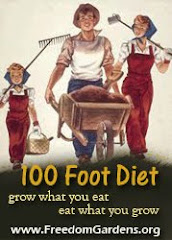Winters in the high mountains of West Virginia are long, cold, dark, isolating, snowy, and really hard work. We spend much of our time splitting and stacking wood, tending to the fire, and keeping the sidewalk and driveway clear of snow. I always chuckle when our guests at The
Ponderosa Lodge mention our "simple" life here because it is any thing but simple. Basic, yes; simple, not exactly. So, when the weather breaks and the temperature is unusually warm (
ie. slightly above freezing) for a week, it is nice to get out and do something. My husband bought me a set of wood carving tools for Christmas (pictured below), so I decided to head down to our friend
Dennis's wood workshop to learn how to carve a wood bowl.

Dennis is a native of West Virginia, and he has been carving for more than 50 years. If you have ever visited The
Ponderosa Lodge, you will recognize his beautiful work because he carved the coffee table, sofa table, and end tables in the Great Room. He also carved all of our bread bowls, and we sell these items and many more at the lodge. Below is a photo of a big beautiful bowl carved from a tree knot that he is working on for us.

Unfortunately, when I arrived at
Dennis's workshop (pictured below), he was not feeling well because he had a chemotherapy treatment yesterday, so I spent the day carving with his brother, Mac, and his wife, Dee.

This is the inside of
Dennis's wood workshop and some of his cool power tools.

This is the piece of wood that I started with. It is a piece of cherry log split down the middle. I plan to carve it into a small bowl.

Mac first used a drill press to remove a little bit of the wood from the top. This makes the overall process a little bit quicker, and it also makes it easier for me to carve out the inside of the bowl with my carving tools.

Liam and Ken also brought their own "tools," and they joined in the fun.

Liam was very interested in assisting me while I carved. The whole process is fairly simple. Essentially, you hold the gouge (pictured in my left hand) by the wood handle and place the sharp metal end against the wood where you want to carve. Then you hammer the handle of the gouge with a soft headed mallet (pictured in my right hand). The force of the mallet causes the sharp end of the gouge to carve out little pieces of wood. This process allows you to slowly carve out the inside of the bowl. Apparently, the idea is to carve the bowl as thin as possible without actually carving a hole in the bowl. (Although Mac promised me he could patch the bowl if I accidentally do carve a hole in the bowl). Thankfully, I did not chop off any fingers, but I did slice a hole right through my work jeans with the super sharp gouge.

This is my little bowl after about 2 hours of carving.

This is my bowl after about 3 hours of carving. I still need to carve about 1/2" more to create the bottom of the bowl and then carve out the sides as well. Then, I will sand the inside and outside of the bowl. I plan to keep most of the bark on the outside, but Mac will sand around the corners so they are rounded rather than square.

Dee sanded these bowls while I carved mine. Sanding is one of the final steps in the process. She is nearly done with these bowls.
















































